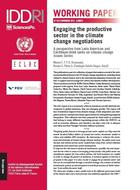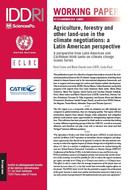This publication is part of a collection of papers that analyze several of the technical and political issues in the UN climate change negotiations, including those related to climate finance and to the international adaptation framework; and how to support and encourage low-carbon and climate-resilient development. This work series was led by IDDRI and jointly prepared with experts from four Latin American & Caribbean think tanks (Brazil, Argentina, Peru, Costa Rica, see A perspective from Latin American and Caribbean think tanks on climate change issues Series).
This paper discusses the issue of climate finance in the context of the future climate agreement and from a Latin American perspective. It analyses the complex challenges of climate finance and suggests options and ideas that could be further explored in the negotiations, and in other fora.
Extrait [en anglais] :
"Mitigation efforts in the region are necessary to increase competitiveness, enhance access to world markets, increase efficiency and to transform and expand the economic and social infrastructure that would be required to adhere to a low emission pathway. Very large urban populations, wide inequalities and acute income distribution gaps make mitigation efforts more demanding and require sophisticated financial instruments to stimulate investments without further impacts on, inter alia, energy tariffs, food prices and public transport costs. Climate finance will also be necessary to make these transformations feasible and to enable a less socially regressive transition process.
Beyond the diverging perspectives of developed and developing countries, mobilizing private funding represents the possibility of tapping vast financial resources while having simultaneous access to innovation and the potential for technical change.
The complementarity of public and private funding can be reinforced by implementing public policies and policy reforms to leverage private climate finance, in particular to address barriers to investment or market failures, including through risk mitigation instruments to lower the level of risk of investments."






